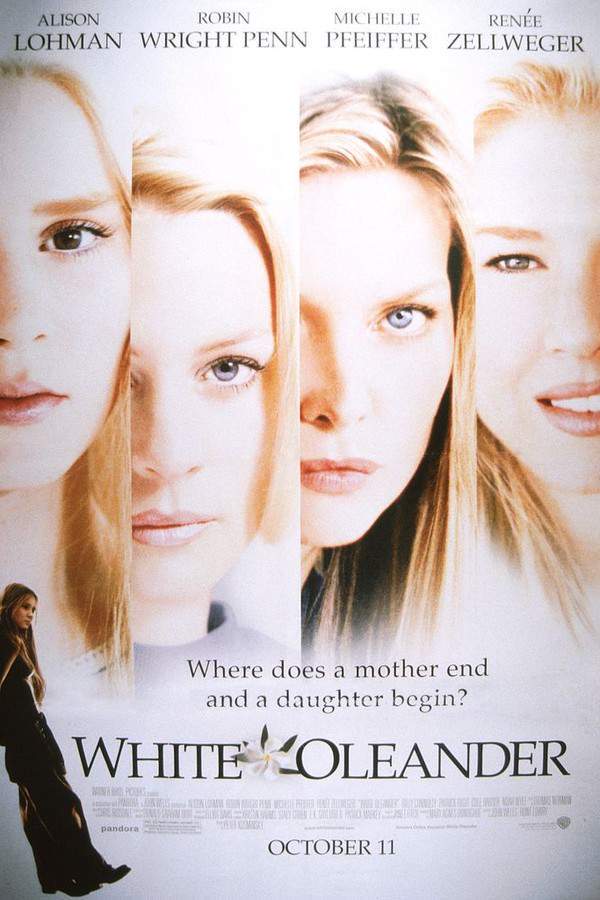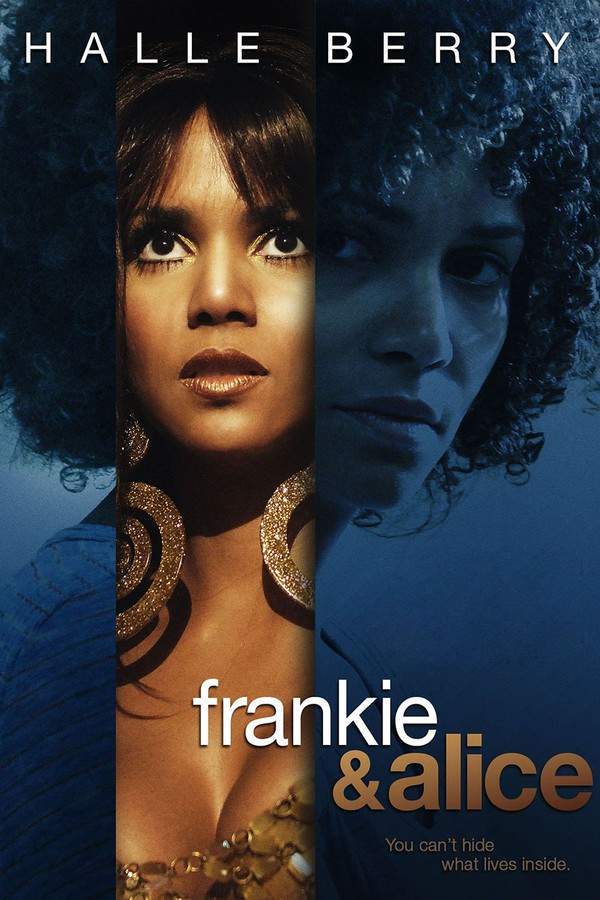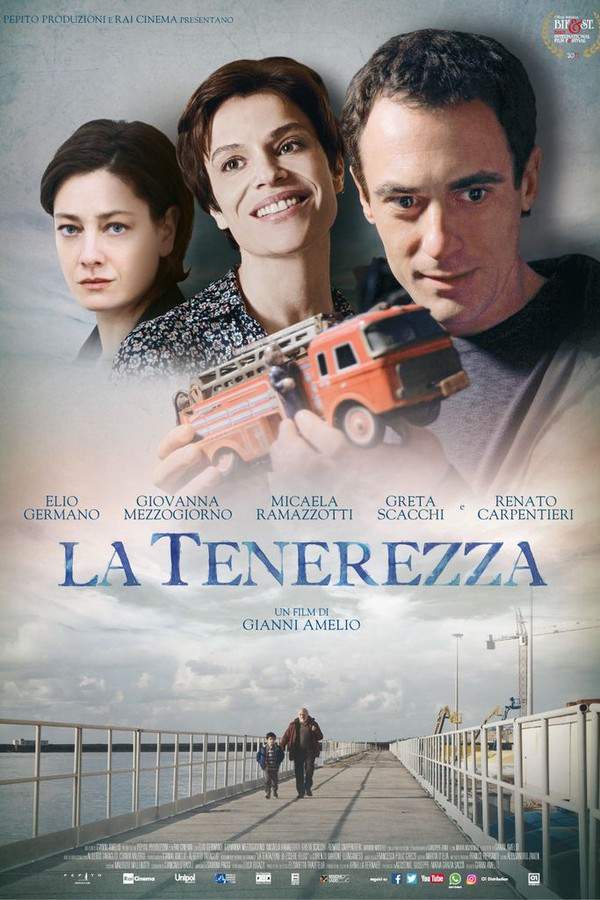
White Oleander 2002
Directed by

Peter Kosminsky
Made by

Warner Bros. Pictures
White Oleander Plot Summary
Read the complete plot summary and ending explained for White Oleander (2002). From turning points to emotional moments, uncover what really happened and why it matters.
Fifteen-year-old Astrid Magnussen finds herself navigating life in Los Angeles alongside her free-spirited artist mother, Ingrid. With no memories of her father, Astrid heavily leans on her self-absorbed mother for support. When Ingrid’s relationship with the writer Barry crumbles due to infidelity, she takes a dark turn by ending Barry’s life using white oleander poison and is subsequently imprisoned. This tragic turn of events leaves Astrid under the guardianship of social services.
Astrid’s first foster mother is Starr Thomas, a recovering alcoholic and former stripper who has found solace in her faith. The duo initially bonds well, even leading to Astrid’s baptism into Starr’s church. However, when Ingrid learns of their connection, she creates tension, spurring Astrid to take a stand. Starr’s jealousy over Astrid’s perceived relationship with her boyfriend Ray drives her back to drinking, culminating in a violent encounter where Starr, in a drunken frenzy, injures Astrid by shooting her in the shoulder. Protecting Starr, the children convince Astrid to remain silent about the incident.
After healing in the hospital, Astrid is transferred to McKinney Children’s Center (also known as “Mac”). There, she experiences conflict with some of the other girls but eventually finds a friend in fellow artist Paul Trout. Her journey continues when she is placed with a former actress, Claire Richards, and her producer husband Mark. The fragile yet caring Claire quickly forms a close bond with Astrid, who seems to flourish under her care. However, when Astrid learns that Ingrid has been writing to Claire, she insists on a prison visit. Unfortunately, Ingrid’s manipulative nature exacerbates Claire’s insecurities regarding Mark, leading to Claire’s tragic suicide. This heartbreaking event deeply impacts Astrid, who feels betrayed by Ingrid.
Astrid telegraphs her grief to Ingrid about Claire’s death and opts not to visit her again, returning to Mac. Conflicted, Paul reveals his imminent move to New York and invites Astrid to join him, but she coldly declines. As she continues to navigate foster care, Astrid finds herself in the care of Rena Gruschenka, a Russian immigrant who exploits the foster children for her business, further hardening Astrid’s demeanor. Rena encourages Astrid to take advantage of an offer from Susan Vallares, Ingrid’s attorney, to testify falsely for her mother in court. Despite Rena’s temptations, Astrid refuses to compromise her integrity.
In an unexpected twist, Astrid pays Ingrid a visit in prison, where she exerts newfound control, demanding the truth about her family history in exchange for testifying that Barry took his own life. The confrontation reveals deep-seated issues about her father, Claire, and a mysterious figure from her past named Annie. As time passes, she and Paul rekindle their relationship, and he attends her mother’s trial as Astrid prepares to give testimony. However, things take a turn when she finds out that Ingrid has instructed her attorney to ignore her statements, leading to a painful goodbye as she watches her mother being taken away once again.
Fast forward two years, a transformed Astrid now resides in New York City with Paul, focusing on her art. She creates thought-provoking dioramas in suitcases, narrating the tumultuous chapters of her life. With each suitcase she closes, she pledges never to revisit the torment within. Pausing at the final suitcase that symbolizes her relationship with Ingrid, she reflects on a bittersweet truth: despite her flaws, she recognizes that her mother loves her in her own complicated way.
White Oleander Timeline
Follow the complete movie timeline of White Oleander (2002) with every major event in chronological order. Great for understanding complex plots and story progression.
Astrid's Life in Los Angeles
Fifteen-year-old Astrid Magnussen navigates life in vibrant Los Angeles alongside her artist mother, Ingrid. She struggles with the weight of not knowing her father and relies heavily on her self-absorbed mother for emotional support.
Ingrid's Infidelity and Violence
Ingrid's relationship with writer Barry falls apart due to infidelity, leading to a tragic climax. In a fit of rage and despair, Ingrid murders Barry using deadly white oleander poison and is subsequently arrested for the crime.
Astrid in Social Services
Following her mother's imprisonment, Astrid is placed under the guardianship of social services. This transition into foster care marks the beginning of a challenging journey for Astrid to find stability and belonging.
Life with Starr Thomas
Astrid's first foster mother, Starr Thomas, is a recovering alcoholic and former stripper who introduces Astrid to her faith. They bond initially, even culminating in Astrid's baptism, which symbolizes a new chapter in her life.
The Downfall of Their Bond
Tensions arise when Ingrid learns about Astrid's newfound connection with Starr, influencing Astrid's choices. Jealousy and alcoholism lead Starr back into darkness, resulting in a violent incident where she shoots Astrid in a drunken rage.
Recovery and Transfer to 'Mac'
After recovering from her injuries in the hospital, Astrid is transferred to McKinney Children's Center, known as 'Mac.' Here she encounters conflicts with other girls but eventually forms a meaningful friendship with artist Paul Trout.
Placement with Claire Richards
Astrid is placed with Claire Richards, a former actress, and her producer husband, Mark. The bond between Astrid and Claire blossoms, providing Astrid with care and support she desperately needs after her turbulent experiences.
The Visit to Ingrid
Upon discovering that Ingrid is writing to Claire, Astrid insists on visiting her mother in prison. This visit stirs old emotions and insecurities, and Ingrid's manipulative behavior significantly affects Claire, ultimately leading to Claire's tragic suicide.
Astrid's Grief and Reflection
Overwhelmed by grief after Claire's suicide, Astrid communicates her sorrow to Ingrid and decides to cease further visits. Choosing to return to Mac, Astrid reflects on the impact of Ingrid's actions on her life and the lives around her.
Conflict with Rena Gruschenka
In her next foster placement with Rena, a Russian immigrant, Astrid faces exploitation. Rena encourages Astrid to betray her integrity by testifying against her mother in court, but Astrid resolutely refuses to compromise her values.
Confrontation with Ingrid
Astrid visits Ingrid in prison again and confronts her about her family's history. This powerful encounter reveals deep emotional scars and forces Astrid to grapple with complicated feelings regarding her mother and her past.
Relationship with Paul Evolves
As time passes, Astrid and Paul rekindle their bond, navigating their complicated feelings together. Paul supports Astrid during her mother's trial, signifying a growing connection amid the turmoil surrounding them.
The Painful Goodbye
During a pivotal moment at Ingrid's trial, Astrid realizes that her mother disregards her statements. This betrayal culminates in a painful goodbye as Astrid watches Ingrid being taken away, highlighting the unresolved issues between them.
A New Beginning in New York City
Two years later, Astrid and Paul begin anew in New York City, where Astrid immerses herself in her art. She creatively expresses her tumultuous journey through captivating dioramas that reflect the significant experiences of her life.
Final Reflection on Ingrid
As Astrid closes the last suitcase that symbolizes her relationship with Ingrid, she reflects on the complexities of love and pain. Despite Ingrid's imperfections, Astrid acknowledges her mother's love for her, showcasing her emotional growth.
White Oleander Characters
Explore all characters from White Oleander (2002). Get detailed profiles with their roles, arcs, and key relationships explained.
Astrid Magnussen
Fifteen-year-old Astrid is caught in a web of familial dysfunction and self-discovery, navigating the highs and lows of foster care. Her complex relationship with her mother and the series of guardians she encounters shape her into a resilient character. Despite numerous challenges, she embodies a strong sense of integrity and growth throughout her journey.
Ingrid
Astrid's free-spirited mother, Ingrid, possesses a charismatic yet self-absorbed personality, deeply impacting Astrid's life choices. Her dark turn following betrayal leads to devastating consequences and sets the stage for a fraught relationship with Astrid. Despite her flaws, Ingrid's love for her daughter is complicated and often misguided.
Starr Thomas
Starr serves as Astrid's first foster mother, a recovering alcoholic finding strength in her faith. Initially supportive, their bond deteriorates as jealousy and insecurity emerge. The combination of her tough exterior and vulnerability creates a multifaceted character affected by her own past and struggles.
Claire Richards
Claire, a former actress, becomes a significant figure in Astrid's life, embodying both care and fragility. Her close bond with Astrid offers a glimpse of normalcy and support, but her insecurities ultimately lead to tragic decisions that deeply impact Astrid. Claire’s nurturing side adds depth to her character, contrasting with Ingrid's darker traits.
Paul Trout
Paul emerges as a pivotal figure in Astrid's life, offering companionship and understanding amid her chaotic surroundings. His artistic connection with Astrid allows her to explore her creative side, fostering a mutual bond of support and healing. Paul's role highlights the importance of friendship during turbulent times.
White Oleander Settings
Learn where and when White Oleander (2002) takes place. Explore the film’s settings, era, and how they shape the narrative.
Time period
The narrative unfolds in a contemporary setting, reflecting the struggles of adolescence in modern society. It captures the essence of the foster care system and familial complications, resonating with the challenges faced by youth today.
Location
Los Angeles, McKinney Children's Center, New York City
Los Angeles serves as the backdrop for Astrid's turbulent childhood, where she navigates the complexities of foster care and family disintegration. The McKinney Children's Center provides a stark yet crucial environment for Astrid's growth and interactions with other troubled youths. Finally, New York City represents a fresh start for Astrid, where she channels her experiences into her art.
White Oleander Themes
Discover the main themes in White Oleander (2002). Analyze the deeper meanings, emotional layers, and social commentary behind the film.
🌪️
Trauma
The theme of trauma is woven throughout Astrid's journey, shaped by her mother's actions and the instability of foster care. Each new environment she enters adds layers to her emotional struggles, showcasing the lasting impact of parental neglect and loss. Astrid's experiences reflect the complexities of healing from deep-seated wounds.
🖌️
Art
Art acts as a vital outlet for Astrid, enabling her to process her tumultuous emotions and experiences. Through her creative expressions, particularly with dioramas, she narrates her life's chapters and confronts her painful past. This theme underscores the transformative power of art in personal healing.
⚖️
Integrity
The theme of integrity becomes increasingly significant as Astrid is faced with choices that challenge her morals. Her refusal to testify falsely for her mother highlights her commitment to honesty, even amid manipulation and pressure. This theme emphasizes the importance of staying true to oneself despite external influences.
Movies with Similar Twists and Themes
Uncover films that echo the narrative beats, emotional arcs, or dramatic twists of the one you're exploring. These recommendations are handpicked based on story depth, thematic resonance, and spoiler-worthy moments — perfect for fans who crave more of the same intrigue.
Featured on this page

What's After the Movie?
Not sure whether to stay after the credits? Find out!
Explore Our Movie Platform
New Movie Releases (2025)
Famous Movie Actors
Top Film Production Studios
Movie Plot Summaries & Endings
Major Movie Awards & Winners
Best Concert Films & Music Documentaries
© 2025 What's After the Movie. All rights reserved.









